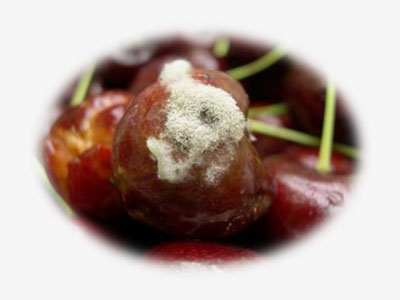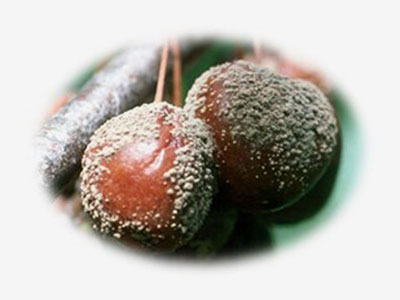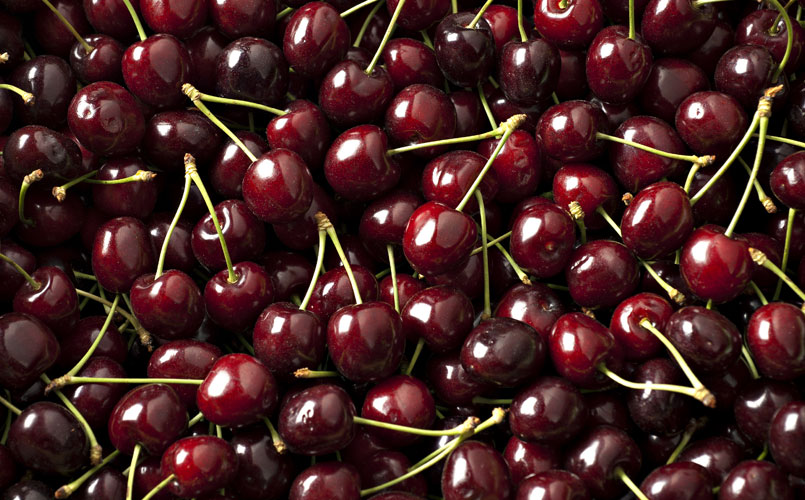Protect the Value of your Cherries this Season
With the unseasonably mild, wet weather encountered in the Pacific Northwest this cherry season, growers should be mindful of the decay risks facing their crop. Both brown rot (Monilinia fructicola) and Botrytis blossom blight (Botrytis cinerea) are favored by mild temperatures and frequent rain events.

Brown rot caused by Monilinia fructicola
In the case of brown rot, the fungus can overwinter on infected twigs, branches, mummified fruit, and flowers. Temperatures above 40°F favor fungal spore production, while temperatures above 50°F favor infection. Although flowers are more susceptible to infection during bloom, infections can occur throughout the growing season given favorable environmental conditions are met. Developing fruit are highly susceptible to infection as ripening progresses, and this can be exacerbated by rain events which serves to spread pathogen spores throughout the crop canopy. Late season infections may be latent at harvest, becoming symptomatic during storage.

Gray mold caused by Botrytis cinerea
Botrytis blossom blight is also favored by cool, wet weather during flowering. The fungus invades floral parts, spreading from the inflorescence to the developing fruit. The fungus can survive in the orchard on infected floral parts, mummified fruit and plant debris on the orchard floor, further releasing spores during periods of favorable weather. Additionally, rain events occurring in the weeks and days leading up to harvest enhance the risk of other postharvest fruit decays such as Rhizopus rot (Rhizopus stolonifer) and gray mold (B. cinerea).
These and several other postharvest decays prevail in cherries exhibiting rain-induced cracking. Fortunately, Pace’s Shield-Brite FDL 230SC (fludioxonil) working together with an effective water sanitation system (like Pace AccuTabs managed by Pace’s pH/ORP systems) offers highly effective control of these decays in cherry and other stone fruit hosts.
Postharvest applications made soon after harvest can provide protection against these decays and is highly recommended for cherries during wet seasons to extend their transportability and retail shelf life.
Given the expected higher postharvest disease pressure to be seen this year, Pace recommends the following steps to help protect your valuable cherries:
- Consider cooling and applying a fungicide on the fruit promptly after harvest. Use of Shield-Brite FDL in hydrocoolers, besides line applications, is highly recommended to increase opportunity for good fungicide coverage and penetration in wounds or microcracks, and offer better decay protection in sensitive cherries
- With single applications, increasing dosing of Shield-Brite FDL (up to 600 ppm – or max rate) is recommended to improve residues and protection of sensitive fruit, especially when there is presence of microcracks in the cuticle. The use of Pace’s intelligent Charge & Maintain equipment help maintain consistent fungicide doses in tanks and recirculated dip systems during the entire process, providing you with the peace of mind that the fruit is receiving the right amount of fungicide at all times.
- Adding OptiCal® to water bodies in your line can help decrease the osmotic pressure differential between the flume water and the cherries, helping reduce the exacerbation of skin microcracking as potential entry points of fungal pathogens.
- BioSpectra 100 SC is a novel biofungicide available from Pace, with broad spectrum control on cherry decay pathogens. BioSpectra is exempt of residue tolerance in the US and has a unique FRAC mode of action. Contact your Pace representative to discuss if BioSpectra could help reinforce your postharvest decay control program this year.
Pace International is the global leader in offering advanced postharvest products, technologies, and services for Cherry packers in North America and Chile. Contact your local Pace representative to learn more about strategies to minimize cherry decays and maximize postharvest life and quality.












